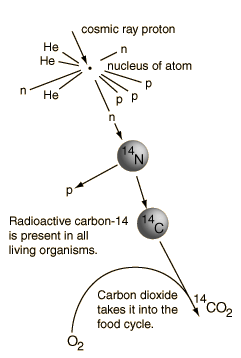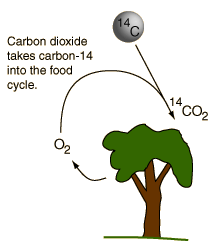Role of Carbon Dating
 | Carbon dating is a very different class of nuclear dating from the "clocks in the rocks" since it depends upon the continuous production of the radioisotope 14C in the atmosphere by cosmic ray collisions with nitrogen atoms. That forms a tiny fraction of the carbon taken in by living organisms and provides a detectable radiation signal which decays over time with a half-life of about 5730 years. |
Carbon dating is particularly valuable for correlation with other clocks and calendars in the living world, such as tree rings and lake varves. Since the half-life is short compared to the geological time scale, it is limited to time frames up to maybe 50,000 years. Past that, the signal is down to about background level and the possiblity of sample contamination becomes a major issue. |  |

| Outline |
References